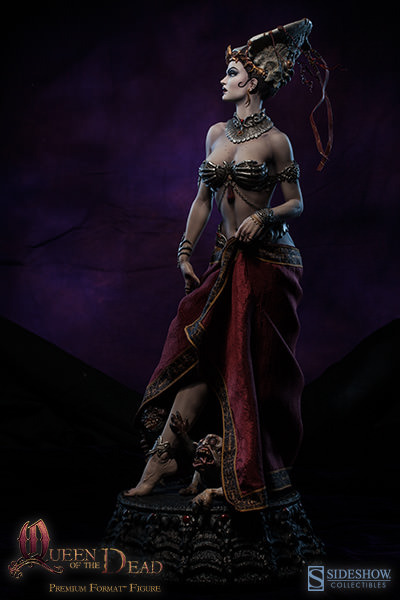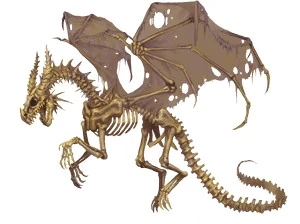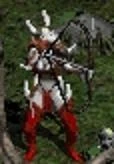In case you thought I forgot about working on Necromancy, I haven't – I've just been busy with work due to the Christmas season, and with some other work with Halo. I am still definitely working on Necromancy, and I thought I'd write a blog to talk about some of the things that I've learned from additional playtests, as well as introducing you to the Queen cards of the four suits (Skeletons, Zombies, Ghosts, and Ghouls, in case you've forgotten.).
First things first, we'll start with...
The Second Playtest
The
start of the second playtest made me realize I had an unclear rule
regarding the Overtake mechanic (where a dormant creature can destroy
a creature summoned on top of it once a soul stack reaches a certain
number of souls) – It wasn't made clear in the rules that Consuming
a creature voided all “Dormant” souls, permanently preventing
them from being used to Overtake. I've got some ideas on some other
ways to handle this other than outright preventing it, but for now
I've just set the rules to where once a creature (and its soul stack)
are Consumed, those souls are JUST souls for the remainder of the
match.
The
Pac Man mechanic (if you forgot, basically, you create a line of
souls and move a weak creature each turn onto a new soul in order to
build your Soul Stack to Overtake with a stronger creature) was in
full swing in this game, but a more interesting metagame developed
where attempted Pac Man chains from Destroyers would be interrupted
by 1 Cost Fodder being summoned in the way. (This doesn't work
versus Consumers, as it simply feeds them faster) – but for
Destroyers, it effectively causes one Soul Stack to build and build
until an even stronger creature can be summoned on the spot and stop
the Pac Man in its place.
This
game ended up with a Lame Duck ending similar to the first test's,
however, as the same Consumer managed to get too far ahead and become
unkillable.
The Third Playtest
The third
playtest, I decided to test a different strategy from the previous
(where I was pretty focused on either player going for a bigger
creature early) – instead I went for a low level creature
immediately and attempted to Pac Man from the start. Both players
had to posture for position on the Graveyard to Pac Man without
moving into range of one another...or to interrupt the others'
attempts. Blatantly obvious Overtake Traps (or benign bluffs) could
also be set in the opponent's Pac Man path to make them change
directions toward a future play, reassuring me that the game's depth
of player interaction was definitely going to be good once a player
base that wasn't me playing against myself was developed.
Much of the
third's playtest (nearly 15 turns per side) revolved around a
Hungering Carcass (basically a Fodder Ghoul) that had been possessed
by Player 1's Spirit (a fodder Ghost possessor that granted bonus
health and made it very difficult to kill without stronger
opponents...though, there's a catch-22 here that every soul consumed
by the possessed Carcass at the time actually counted toward the
opposing player's score, since the Owner of the Hungering Carcass was
Player 2.
By Turn 30, the
score (not final until the game actually ends) was 24-4 in favor of
Player 2, thanks to an amassed stack of souls on the possessed
Carcass, as well as a Bone Warrior that was Pac Manning his way to
prepare to summon the Icon of Death (Ace of Ghosts).
On a late turn,
Player 1 finally Overtook one of Player 2's Soul Stacks with the
Queen of Ghouls (Blood Raven), drastically shifting the score (22-17,
still in player 2's favor).
As Player 1 was
poised to win with Blood Raven amassing a stack of souls, Player 2
responded with Open Grave (the King of Zombies...and also the
creature that had single-handedly won games 1 and 2.) The game ended
with Player 2 using Open Grave to attack and consume his own Icon of
Death to keep the opposing Blood Raven from doing so and stealing
those final souls, a decision which ultimately ensured Player 2's win
26-25 as his final discard onto the field was the only neutral soul
left in play when both players ran out of cards.
Lessons Learned
- Open Grave was too overpowered and needed to be nerfed. He has been nerfed since those playtests.
- Don't make creatures whose Health AND Attack are increased by the number of souls in their soul stack also be Consumers. I ended up nerfing him by making his health a flat amount that does not increase, but he can regenerate health by consuming.
- Pac Manning, although it started as emergent counterplay to huge creatures, has pretty much become core to the Necromancy experience, building up huge Soul Stacks by using fodder units to “carry” them around the field and stay away from enemy units.
- But, enemies can interfere with your route by their own positioning, or by discarding along your route to bait an Overtake, as they cannot move+overtake in the same turn, so moving onto a card you have placed in their intended path gives you Overtake advantage.
- The ability to attack your own creatures can lead to some interesting interactions and clutch situations, especially when Consumers whose attack values are based off the number of Souls in their soul stack are involved.
- Blood Raven didn't actually fit the design of other Queens, while Devourer (King of Ghouls) seemed more Queeny. I needed to swap their designs.
So, now, moving
on... let's talk about
The Queens of the Undead
Before I ever
designed any of the cards for Necromancy, I made an outline/rubric
for each Suit. The Ace of the base set would be one of the Four
Horsemen of the Apocalypse (Icon of War, Icon of Death, Icon of
Pestilence, Icon of Famine). 2, 3, and 4 were Fodder. 5, 6, and 7
were a little stronger. 8 and 9 strong, but still pretty basic. 10
and Jack were Special creatures that were Strong. Kings were Major
Threats (I overstepped with King of Zombies, as I've mentioned.).
But the Queens... I gave them something a bit special. I wanted them
to be higher cost cards than all but the Aces/Icons (which gain power
based off other cards of their suit in the Graveyard and cannot be
Overtaken.)
Originally, I
didn't put much thought into how I wanted this to play out, and a few
of the Queens were fairly boring (namely the Skeleton and Ghost
Queens). Neither of them saw play in the first three Playtests, and
I realized why they felt boring. They basically had no benefit for
costing so much compared to Consumers who'd cost less (which is also
why Blood Raven saw play in Playtest #3, since her design was more
akin to a King.)
I realized shortly
after what I wanted to do with Queens – I wanted them to each be a
surge of power for high cost, high risk, high reward impact on a
gameplay. A power spike, if you will. A table flipper that could
shake up the situation on the Graveyard, but if not handled properly,
just as much a liability for the user. Because that's what you'd
expect from a Queen. For them to be the divas of the stage who need
special attention.
The Queen of Skeletons
Although I have
made drastic changes to the original incarnations of the Queens,
their identities have not changed... and the Queen of Skeletons is
none other than the Bone Dragon.
When trying to
figure out what a Bone Dragon should be able to do that would make
her feel like a surge of power, I paid close attention to the part
where SHE'S A FUCKING DRAGON. A dragon will fly from its nest, wreak
havoc, and then return home.
So for the Queen
of Skeletons, the Bone Dragon... the card effects read as follows:
(pardon the weird formatting, these are copy/pasted from an OpenOffice Calc spreadsheet, and apparently neither OpenOffice Writer nor Blogger's website enjoy that)
Bone Dragon may target any tile in the Graveyard to declare an attack.
|
Basically, she can
set up shop in the corner of the Graveyard, and then say “FUCK YOU
I'M A DRAGON” on any weak monsters you believe you are going to use
as Pac Man fodder. However, she has a limited amount of ammo for her
long-ranged attacks, as her attacks get weaker and weaker with each
attempt. At present, she has 12 Damage for her starting Damage, so
essentially she gets to attack 6 times before she retires to a
mountain of gold and the desolation of smugly fucking over your
opponent's strategy.
The Queen of Ghosts
The Queen of
Ghosts was the first Ghost I named, because I knew it positively had
to be the Banshee.
Because the
general theme for the Ghosts' suit is Possessors, I wanted to
actually keep the Ghost Queen a Possessor, so I needed to focus on
how to create a power spike from a creature designed around
possessing other creatures.
While most
Possessors are focused around empowering another creature (giving
them health, or damage, or the taunt ability or the ability to
reanimate...and if you think that's odd, bear in mind you can possess
your own creatures as well, essentially using Ghosts as Equipment
Cards for your fellow creatures.) I took a different route with the
Banshee.
Banshee starts off
with healthy chunk of health, making her hard to kill. However...
| Banshee loses 3 Health during each of its Owner's Upkeep Phases. |
But she's a
Possessor, so she still wants to possess someone else, yeah?
| If Banshee possesses a creature, the possessed creature becomes the target of Banshee's effect. |
Basically, Banshee
is a Ghost you summon in order to drain the life of an opposing
creature slowly (or just enough to weaken them for a coup-de-grace
from one of your other creatures.) In short, she's a ticking time
bomb you want to attach to an enemy creature.
Oh, and if you're
a Halo fan and you're reading this, don't think I didn't include a
Banshee Bomb... here's Banshee's Crypt effect:
| Banshee may inflict its Health as Damage to an adjacent target. Destroy Banshee. |
(Crypt effects
currently are effects that are only active when the creature is
active on the tile where the first creature of the game was summoned.
This helps to create a sort of arms race for someone to summon the
first creature, as well as a point of power for which both players
want to fight for control.)
The Queen of Zombies
When I was
thinking of a Queen for Zombies... I couldn't help but get a (WARNING: NSFW IMAGE) specific creature (WARNING: NSFW IMAGE) from the Gantz manga out of my head.
The Queen of
Zombies in Necromancy is known as the Corpse Golem. Because of
science. And Japan.
The Corpse Golem
is the only creature that hasn't needed to change from its initial
creation to my “reworking Queens” pass. Her effects are as
follows:
| Corpse Golem's Damage is increased by 1 for each Soul in its Soul Stack. |
| Corpse Golem's Health is reduced by 3 each time it attacks. |
She has a fairly
low base attack (because the casting cost is added into it), but
similar to Banshee, she has high base health, because any time she
takes action, her health is whittled down. This means she can pack a
whollop for a few turns before she finally calms down (or destroys
herself). If her Controller has control of the Crypt as well, she
can move there in order to regenerate some health each turn.
I feel she really
embodied (eh heh heh) my initial plans for Queens quite well, and she
was the paradigm I used to redesigning the other 3.
Finally, we move
on to
The Queen of Ghouls
If you're
wondering why I named the Queen of Ghouls Blood Raven, it's partially
because the Ghoul fodder is called Carrion Crow. It's also partially
because of Diablo 2, and partially because of Game of Thrones. Blood
Raven is a familiar name to a wide variety of nerd subcultures.
With that said, my
main problem with her original design was...well, she was the type to
get stronger as a battle went on. It's why she put Player 1 in the
position to come back and win playtest #3. She was a Consumer who
got STRONGER as she consumed. Which was the opposite of what I
wanted Queens to be. On the other hand, the King of Ghouls got
weaker as he stayed on the field. Oops! Looked like I had the two's
effects backwards.
As a result, I
effectively just swapped the two. But in the process, I also buffed
Blood Raven's stats considerably to make her more attractive that the
King of Ghouls had been (as I had seen no reason to summon him in any
of the previous 3 games. He seemed like a trash can card.)
Now, Blood Raven
sits at a massive 30 damage and 6 health. Which may seem absurd,
but...
| Blood Raven's Damage is reduced by 2 for every Soul in its Soul Stack. |
By default, she
will never actually have more than 18 damage (since her casting cost
is 6). And, if she destroys any other large stacks, she effectively
neuters herself for the remainder of her life. However, she's still
a massive force to be reckoned with when she first comes onto the
field, giving the exact feel I wanted to evoke from a Queen.
With these card
designs and re-designs, I feel the Queens of every Suit have a
certain similar flavor of play that will both spice up the game and
encourage players to go all-in for a woman they love some time.
That's all for
this second blog on Necromancy. I'm not sure when the next one I'll
post will be (probably sometime within the next 2 weeks, as I will be
making actual distributable decks very soon thanks to a few Christmas
presents I got...so work on Necromancy has resumed.) When I do get
around to it, I'm going to talk about Possessing and Possessors.
If you are
interested in helping me test Necromancy (or sending me any quantity
of money to encourage my continued development of the game), please
reach out to me on Twitter or however you can and we can discuss
details.
Until next time!






No comments:
Post a Comment